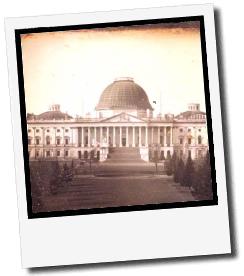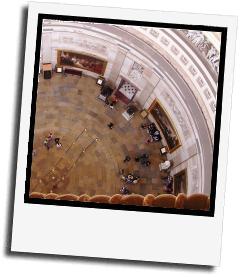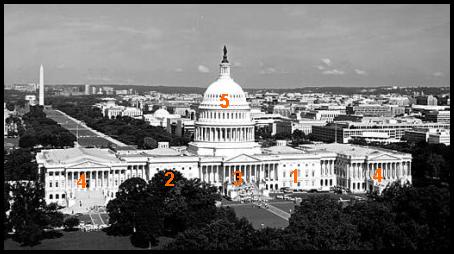
Search
Construction, History and Tour of the U.S. Capitol
Begun in 1793, the United States Capitol has been built, burnt, rebuilt, extended, and restored. The Capitol that we see today is the result of several major periods of construction. In accordance with the "Residence Act" passed by Congress in 1790, President Washington in 1791 selected the area that is now the District of Columbia from land ceded by Maryland. French engineer Pierre L'Enfant was chosen to plan the new city of Washington. He located the Capitol at the summit of what was then called Jenkins' Hill.

![]() Dr. William Thornton was accepted by the Commissioners; Washington gave his formal approval on July 25. Thornton's plan depicted a building composed of three sections. The central section, which was topped by a low dome, was to be flanked on the north and south by two rectangular wings (one for the Senate and one for the House of Representatives). The cornerstone was laid by President Washington in the building's southeast corner on September 18, 1793, during a Masonic ceremony.
Dr. William Thornton was accepted by the Commissioners; Washington gave his formal approval on July 25. Thornton's plan depicted a building composed of three sections. The central section, which was topped by a low dome, was to be flanked on the north and south by two rectangular wings (one for the Senate and one for the House of Representatives). The cornerstone was laid by President Washington in the building's southeast corner on September 18, 1793, during a Masonic ceremony.
.

![]() Senate wing (1) was completed first in 1800 to which resided the Senate chambers, the House chambers, the Supreme Court, the District courts, and the Library of Congress.
Senate wing (1) was completed first in 1800 to which resided the Senate chambers, the House chambers, the Supreme Court, the District courts, and the Library of Congress. ![]() Benjamin Henry Latrobe was appointed architect to oversee the construction effort and the House wing (2) was completed in 1811. The House moved its chambers to the new south House wing in 1809 (now known as
Benjamin Henry Latrobe was appointed architect to oversee the construction effort and the House wing (2) was completed in 1811. The House moved its chambers to the new south House wing in 1809 (now known as ![]() Statuary Hall – where in 1864 Congress invited each state to contribute two statues of prominent citizens for display). In 1808, Latrobe began the rebuilding of the north Senate wing, which had fallen into disrepair. Among his changes was the addition of a chamber for the Supreme Court, occupied from 1810 and 1860. The Supreme Court chamber is now a museum open to tours.
Statuary Hall – where in 1864 Congress invited each state to contribute two statues of prominent citizens for display). In 1808, Latrobe began the rebuilding of the north Senate wing, which had fallen into disrepair. Among his changes was the addition of a chamber for the Supreme Court, occupied from 1810 and 1860. The Supreme Court chamber is now a museum open to tours.
The War of 1812 left the Capitol in ruin. August 24, 1814, British troops set fire to the building, and only a sudden rainstorm prevented its complete destruction. Latrobe began to make repairs to the remains of the Capitol and took advantage of this opportunity to make further changes in the building's interior design by an enlargement of the Senate Chamber and introducing new materials such as marble discovered along the upper Potomac.

![]() Charles Bulfinch, was appointed Latrobe's successor as architect. Bulfinch continued the restoration of the north Senate and south House wings and also redesigned and supervised the construction of the Capitol's central
Charles Bulfinch, was appointed Latrobe's successor as architect. Bulfinch continued the restoration of the north Senate and south House wings and also redesigned and supervised the construction of the Capitol's central ![]() Rotunda (3). A copper-covered wooden dome topped this section. After completing the last part of the building in 1826, Bulfinch spent the next few years on the Capitol's decoration and landscaping. The Capitol's length was 351 feet 7-1/2 inches and width was 282 feet 10-1/2 inches. Records show the up to the year 1827 the project cost was $2,432,851.34.
Rotunda (3). A copper-covered wooden dome topped this section. After completing the last part of the building in 1826, Bulfinch spent the next few years on the Capitol's decoration and landscaping. The Capitol's length was 351 feet 7-1/2 inches and width was 282 feet 10-1/2 inches. Records show the up to the year 1827 the project cost was $2,432,851.34.
By 1850 the Capitol's size could no longer accommodate the increasing numbers of senators and representatives from newly admitted states. President Millard Fillmore chose ![]() Thomas Walter to supervise the construction of the extensions (4) and
Thomas Walter to supervise the construction of the extensions (4) and ![]() new dome (5). Marble was chosen for the exterior in lieu of the deteriorating Aquia Creek sandstone.
new dome (5). Marble was chosen for the exterior in lieu of the deteriorating Aquia Creek sandstone.

![]() "Statue of Freedom" arrived from its sculptor's studio in Rome at a height of 19 feet 6 inches, to be placed on the crown of the new dome. The interior of the dome was completed in 1866 with the fresco,
"Statue of Freedom" arrived from its sculptor's studio in Rome at a height of 19 feet 6 inches, to be placed on the crown of the new dome. The interior of the dome was completed in 1866 with the fresco, ![]() "Apotheosis of Washington," hanging 180 feet (or 18 stories) above the Rotunda floor.
"Apotheosis of Washington," hanging 180 feet (or 18 stories) above the Rotunda floor.
It has taken nearly 75 years to get to the appearance of the U.S. Capitol Building that we see today. Not to mention the on going up keep and renovations taken on by the Architect of the Capitol. Current construction to the grounds is the U.S. Capitol Visitor Center scheduled to be completed late 2007. At nearly 580,000 square feet, the visitor center is the largest project in the Capitol’s 212 year history and is approximately three quarters the size of the Capitol itself. The entire facility is located underground on the east front of the Capitol so as not to detract from the appearance of the Capitol.
